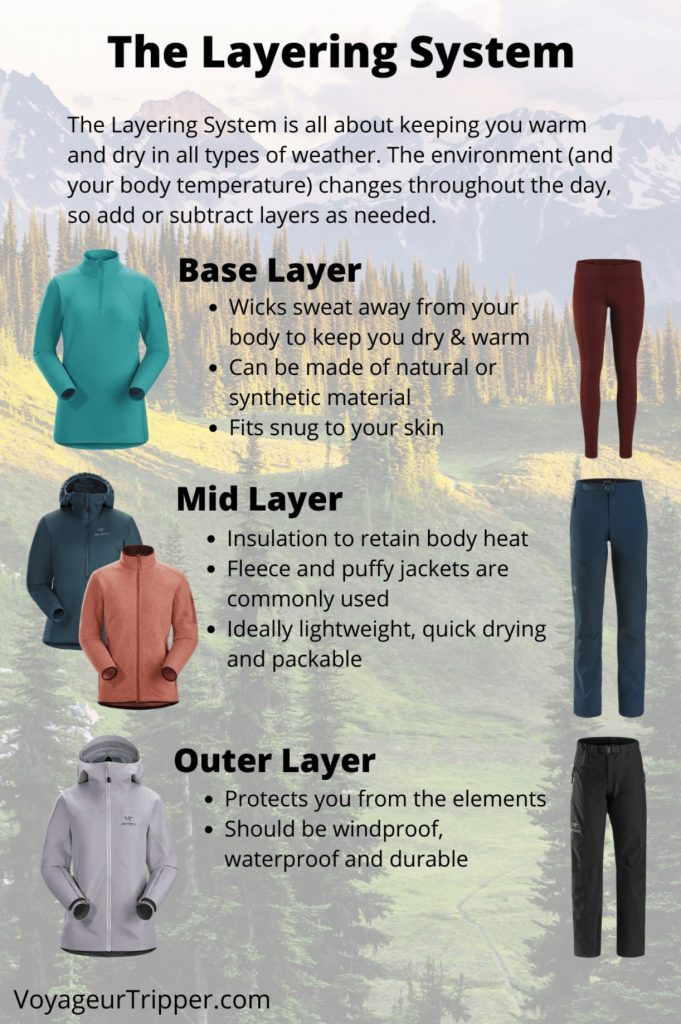Layering clothing is key for optimal warmth in cold weather hiking. Here’s how to do it effectively.
Are you planning on hiking in cold weather? Properly layering your clothing is crucial for staying warm and comfortable throughout your journey. By following a few simple steps, you can ensure optimal warmth and protection from the elements. We will discuss the importance of layering, the different types of layers, and how to effectively choose and arrange your clothing for maximum warmth.
Whether you are a beginner or an experienced hiker, mastering the art of layering will elevate your hiking experience and keep you cozy in even the coldest conditions. Read on to discover the secrets of staying warm during cold weather hiking adventures.
Understanding The Basics
Understanding the basics of layering is crucial for optimal warmth during cold weather hiking. When planning your clothing strategy, consider different types of layers – base, mid, and outer layers. Base layers help regulate body temperature and moisture-wicking. Mid layers provide insulation and added warmth.
Outer layers protect against wind, rain, and snow. Analyzing weather conditions is vital in choosing the right layers, ensuring comfort and safety. Pay attention to fabrics that are moisture-wicking, breathable, and insulating. Proper layering not only keeps you warm but also allows for easy adjustment based on activity level and changing weather conditions.
So, next time you embark on a cold weather hike, remember the importance of layering and select the appropriate clothing for a comfortable and enjoyable experience.
Base Layers: The Foundation Of Warmth
Base layers serve as the foundation for keeping warm while hiking in cold weather. They play a crucial role in insulation by selecting moisture-wicking and breathable materials. When it comes to thermal base layer options, two popular choices are merino wool and synthetic fabrics.
Merino wool provides natural warmth and odor resistance, while synthetic fabrics offer quick-drying properties. Additionally, ensuring a proper fit and comfort is essential for maximizing warmth and allowing freedom of movement on the trail. By following these guidelines, you can layer your clothing effectively to stay cozy during cold weather hikes.
Remember, the key is to choose the right materials, focus on insulation, and prioritize comfort for an optimal outdoor experience. By doing so, you can fully enjoy your winter adventures without worrying about chilly temperatures.
Mid Layers: Adding Insulation
Layering clothing is essential for staying warm during cold weather hiking. When it comes to adding insulation, mid layers are crucial. These layers have a specific purpose and offer a range of benefits. Fleece jackets and pullovers provide excellent warmth while being lightweight and breathable.
Insulated vests are a versatile choice, perfect for keeping your core warm. Down jackets are incredibly warm, thanks to their high-quality insulation. When selecting a mid layer, it’s important to choose the appropriate thickness and weight for the conditions you’ll be hiking in.
By carefully layering your clothing, you can ensure optimal warmth and comfort during your cold weather hikes.
Outer Layers: Protection From The Elements
Layering clothing is crucial for staying warm during cold weather hiking. When it comes to outer layers, protection from the elements is key. To shield yourself from wind and rain, consider windproof and waterproof options. Hardshell jackets provide excellent protection against harsh weather conditions.
Softshell jackets offer flexibility and breathability. Insulated outer layers provide added warmth, retaining body heat without compromising mobility. Additionally, you can layer with a poncho or rain cover to keep yourself dry. By layering appropriately, you can optimize warmth while hiking in cold weather.
Accessorize For Warmth
Layering clothing is essential for staying warm while hiking in cold weather. Accessorizing can greatly enhance warmth. Hats, beanies, and headbands provide insulation for the head, preventing heat loss. Neck gaiters and scarves can be wrapped around the neck and face for added protection against chilling winds.
Don’t forget gloves or mittens to keep your hands cozy and functioning well. Equally important are thick woolen socks that provide insulation and cushioning to your feet. Lastly, choosing the right footwear is crucial. Opt for insulated, waterproof boots that provide good traction on snowy or icy terrains.
By following these tips, you can ensure optimal warmth and comfort during your cold weather hikes. Stay cozy and enjoy your outdoor adventures!

Credit: www.voyageurtripper.com
Putting It All Together: Layering Techniques
Putting together the perfect layering system is essential for staying warm while hiking in cold weather. Start by adjusting layers based on activity and temperature. Layering in the right sequence is key to maximizing warmth. Remember to regulate your body temperature on the go, as you may need to remove or add layers as you hike.
By following these guidelines, you can ensure optimal warmth and comfort during your cold weather adventures.
Tips For Cold Weather Hiking
Layering clothing properly is essential for staying warm while hiking in cold weather. To stay hydrated, carry a water bottle with an insulating cozy and drink regularly. Exposed skin can be protected by using a combination of sunscreen, lip balm, and a hat.
Prevent chilling from perspiration by wearing moisture-wicking base layers and adjusting your clothing as needed. Layering is key in adapting to changing weather conditions; a base layer, mid layer, and outer shell provide flexibility. Remember to adjust layers according to your activity level and the temperature, ensuring optimal warmth and comfort while hiking in the cold.
Frequently Asked Questions Of How Do I Layer Clothing For Optimal Warmth In Cold Weather Hiking?
How To Layer Clothes For Cold Weather Hiking?
Layering clothes for cold weather hiking involves wearing multiple thin layers to insulate, trap heat, and protect from the elements.
How Many Layers Should I Wear For Winter Hiking?
For winter hiking, wear three layers: base (moisture-wicking), insulation (warmth), and outer (waterproof and windproof).
What Are The 3 Different Types Of Layers One Should Wear When Dressing For Cold Weather?
When dressing for cold weather, you should wear three types of layers: base layer, insulating layer, and outer layer.
What Is The Correct Order Of The Three Layer Clothing Principle In Hiking?
Base layer, mid layer, and outer layer are the three layers in the correct order for hiking clothing.
Conclusion
To ensure optimal warmth during cold weather hiking, layering your clothing is key. Layering allows you to trap heat and regulate your body temperature as needed. Start with a moisture-wicking base layer to keep sweat away from your body. Next, add an insulating mid-layer such as a fleece or down jacket to provide warmth.
Outer layers should be windproof and waterproof to shield you from the elements. Don’t forget to wear proper accessories like hats, gloves, and insulated socks to keep extremities warm. Remember to adjust your layers as you hike, removing or adding as necessary to prevent overheating or becoming too cold.
By following these guidelines, you can stay comfortable, warm, and protected during your cold weather hiking adventures. So, don’t let winter weather stop you from exploring the great outdoors – simply layer up and enjoy the beauty of nature!



